In an unprecedented development that has sent waves of excitement across both the football and marching band communities, the Ohio State Marching Band (OSUMB) has been selected to perform at the 2026 FIFA World Cup Final halftime show. This momentous occasion will mark a historic milestone for the band, making them the first collegiate marching band in history to be chosen for such a prestigious global stage. As anticipation builds, details surrounding their performance are beginning to take shape, with a blend of anticipation, pride, and the gravity of the event in play. However, along with the honor comes a set of strict conditions that will test the limits of their preparation and artistry, setting the stage for a truly unforgettable spectacle.
The 2026 FIFA World Cup will be held across three host nations: the United States, Mexico, and Canada. With millions of eyes from around the world poised to watch, the halftime show of the final match will serve as one of the most anticipated events of the tournament. Halftime performances at the World Cup Final have traditionally featured top-tier global artists and entertainers, often showcasing grandiose spectacles that combine music, dance, and cutting-edge technology. For OSUMB, known for their precision, innovation, and deep ties to the American college football scene, this is a golden opportunity to put their talents on the world stage and showcase the powerful connection between sports and music.
The Ohio State Marching Band has long been recognized for its exceptional performances, but being tapped for such a global event signifies the band’s place at the pinnacle of collegiate music performance. The band, often referred to as “The Best Damn Band in the Land,” has built a legacy that stretches back over a century. From their intricate formations at Ohio State football games to their performances in major parades, the OSUMB has earned an international reputation. However, performing at a World Cup Final is an entirely different level of exposure, and it carries with it expectations that will be difficult to meet.
The conditions surrounding the band’s performance at the World Cup are as stringent as they are exciting. For starters, the performance must adhere to FIFA’s strict guidelines regarding duration, content, and performance logistics. FIFA has outlined that the halftime show must be no longer than 15 minutes, a very brief window when considering the scale of the spectacle being assembled. The Ohio State Marching Band, known for their elaborate formations and intricate musical arrangements, will need to condense their usual routines into a performance that delivers maximum impact in a short amount of time. They will need to craft a performance that speaks to the global nature of the event, pulling from musical traditions that resonate across diverse cultures while still showcasing the unmistakable style of an American college marching band.
Moreover, the band will face logistical challenges that extend beyond the performance itself. The 2026 World Cup will be held in multiple venues across three countries, which means that OSUMB will have to adapt to various performance spaces, climates, and regional differences in sound quality. The challenge of rehearsing and preparing for such a grand performance will require immense coordination, as the band will need to travel to different cities and venues in advance of the final. They will be working within the confines of FIFA’s official schedule, making every minute of rehearsal crucial to achieving the level of precision for which they are known.
In addition to these logistical hurdles, the band will be expected to synchronize with other elements of the halftime show, which will likely feature a combination of international performers, choreographed routines, and high-tech visual effects. Collaborating with these other artists will require seamless coordination and adaptation to different styles of performance, which may be a departure from the band’s typical experience of working within a purely marching band context. Balancing the band’s unique identity with the broader scope of the World Cup spectacle will be one of the most challenging aspects of this performance.
Despite these challenges, the band has expressed a deep sense of pride in being selected for this historic occasion. For OSUMB, the opportunity to perform at the World Cup Final is not just about personal achievement but about representing the legacy of American college football and the unifying power of music. The band’s director, who has led the group through countless performances over the years, has spoken openly about the honor of being chosen to perform at such a high-profile event. “This is a once-in-a-lifetime opportunity for our band members, and we are all deeply aware of the responsibility we carry. We are not only representing Ohio State but the entire collegiate marching band community, and we will do everything we can to rise to the occasion,” the director commented in a statement.
As for the band members themselves, the excitement and pressure are palpable. Many of the musicians and performers who will take part in the World Cup Final halftime show are veterans of OSUMB, known for their ability to perform under pressure. However, the global scale of the event adds a new layer of anticipation. The performance will be seen by an estimated audience of over a billion people, a number that dwarfs the viewership for any college football game, even the biggest matchups in the sport. The stakes are high, and the performance will have to live up to the incredible reputation the band has built over the years.
To prepare for the event, OSUMB will likely engage in an extended period of rehearsal, including private sessions and full-band run-throughs. They will be working with choreographers, sound engineers, and visual designers to create a halftime show that integrates their unique musicality with cutting-edge technology. The use of drones, advanced lighting systems, and interactive displays is expected to play a role in their performance, which will require OSUMB members to adapt to new forms of musical expression and visual storytelling.
One of the most intriguing aspects of the OSUMB’s participation in the World Cup Final halftime show is the cultural exchange that will occur. As the performance is set to be broadcast to a global audience, it presents an opportunity for the band to bridge cultural divides through the universal language of music. With global fans of soccer tuning in, the band will have the chance to introduce elements of American collegiate marching band music to audiences in countries where it is not a prominent tradition. This moment represents an exciting opportunity to expand the reach of the marching band style and perhaps inspire future generations of musicians from diverse backgrounds.
Moreover, this performance will undoubtedly have an impact on the future of collegiate marching bands. The Ohio State Marching Band’s success in this venture could set a precedent for other bands across the country, showing that they too can have a place in global events. In a world where popular culture often highlights individual artists and entertainers, the selection of a collegiate band for such a major event speaks volumes about the lasting power of traditional forms of musical performance and the dedication of the individuals who contribute to them.
For now, the Ohio State Marching Band will continue to prepare for what will be the performance of a lifetime. Their presence at the World Cup Final in 2026 will serve as a testament to the power of perseverance, preparation, and artistry. As they prepare to take the stage before a global audience, the band will undoubtedly be aware of the significance of their role, knowing that they are not only performing for the fans in the stadium but for millions more watching across the globe.
Ultimately, the OSUMB’s performance at the 2026 FIFA World Cup Final will be more than just a halftime show. It will be a celebration of music, culture, and the unifying power of sports. As the band takes their place on the grandest stage in the world, they will do so with the knowledge that they are not only making history but also setting the stage for future generations to experience the joy and artistry that collegiate marching bands bring to the world. The countdown to 2026 has already begun, and with it, the anticipation for what promises to be one of the most unforgettable halftime performances in World Cup history.



